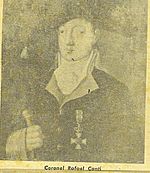Rafael Conti facts for kids
Quick facts for kids
Rafael Conti Flores
|
|
|---|---|

In 1790, Col.Conti captured 11 enemy ships
involved in smuggling stolen goods. |
|
| Born | October 26, 1746 Cadiz, Andalucia, Spain |
| Died | September 26, 1814 Mayagüez, Puerto Rico |
| Allegiance | Spanish Army |
| Years of service | 1790-1814 |
| Rank | Colonel |
| Commands held | Puerto Rican Militia in Aguadilla |
| Battles/wars | Defense of San Juan (1797) |
Rafael Conti Flores was a brave Spanish Army Colonel. He was born on October 26, 1746, and passed away on September 26, 1814. Colonel Conti led the Puerto Rican Militia in the town of Aguadilla. In 1790, he stopped smugglers by capturing 11 ships. He also played a key role in defending Puerto Rico from a British invasion in 1797. Later, in 1809, he helped Spain regain control of Hispaniola, an island now home to the Dominican Republic and Haiti.
Contents
Early Life and Education
Rafael Conti Flores was born in Cadiz, a town in Andalucia, Spain. He went to private schools for his early education. He then trained to become a soldier at a military school. In 1766, after he graduated, he became a Lieutenant of War. He continued to serve in Spain for some time.
Military Career Highlights
Conti was put in charge of the Puerto Rican Militia in Aguadilla. He was also named the sub-delegate of the town's treasury.
Stopping Smugglers (1790)
In 1790, Conti found out that English ships were illegally smuggling stolen goods. These ships were operating close to the coast of Aguadilla. Conti quickly took action. He used a small boat called a sloop and, with his militia, captured 11 of these ships. He took their goods, stopping the illegal activity.
Conti married Juana Josefa Torralbo. Her father, Francisco Torralbo, was the Spanish Governor of Puerto Rico.
Defending San Juan (1797)
On February 17, 1797, the Governor of Puerto Rico, Ramón de Castro, heard that Great Britain had invaded the island of Trinidad. He thought Puerto Rico would be next. So, he prepared the local militia and the island's forts for battle.
After the British soldiers landed, most of the fighting happened on land. There were many small battles and exchanges of cannon fire. The British tried to take the San Antonio bridge, which was a key way to get into San Juan. They heavily bombed the nearby San Gerónimo fort.
At the Martín Peña Bridge, soldiers like Sergeants José and Francisco Díaz and Colonel Conti fought bravely. They used two cannons to attack the enemy. The Spanish forces and local militia fought hard. They stopped the British from moving into San Juan. The invasion failed because the Puerto Rican volunteers and Spanish troops fought with "astonishing bravery."
The British also attacked Aguadilla and Punta Salinas. Colonel Conti, who had been promoted, and his men met them there. The British were defeated and captured. The enemy ships left on April 30 and sailed away on May 2. Because of this victory, Governor Ramón de Castro asked Spanish King Charles IV to honor the heroes. Conti and others were promoted and given more pay.
Hispaniola Expedition (1809)
Spain had given up control of Hispaniola to France in 1697. Later, in 1795, Spain officially gave Santo Domingo (part of Hispaniola) to France. This happened because of the French Revolutionary Wars.
At that time, slaves in Saint-Domingue (another part of Hispaniola) were fighting for their freedom. Their leader was Toussaint Louverture. In 1801, they took control of Santo Domingo, ruling the whole island. However, in 1802, an army sent by Napoleon captured Toussaint Louverture. But his officers, along with a disease called yellow fever, forced the French out again. In 1804, the rebels made Saint-Domingue an independent country called Haiti. France still ruled the eastern part, Santo Domingo.
In 1808, Napoleon invaded Spain. The Spanish people living in Santo Domingo decided to fight against French rule. Colonel Conti organized a plan to bring Hispaniola back under Spanish control. Conti, along with naval Captain Ramón Power y Giralt from Puerto Rico, helped defend the Dominican Republic. They worked with Great Britain (Spain's ally) and Haiti to block the French forces. Because of their efforts, Santo Domingo returned to Spanish rule.
Legacy
Rafael Conti died in Mayagüez, Puerto Rico, on September 26, 1814.
Military Award
Conti received a special military award:
See also
 In Spanish: Rafael Conti para niños
In Spanish: Rafael Conti para niños
- List of Puerto Ricans
- List of Puerto Rican military personnel
- Military history of Puerto Rico
- José and Francisco Díaz

